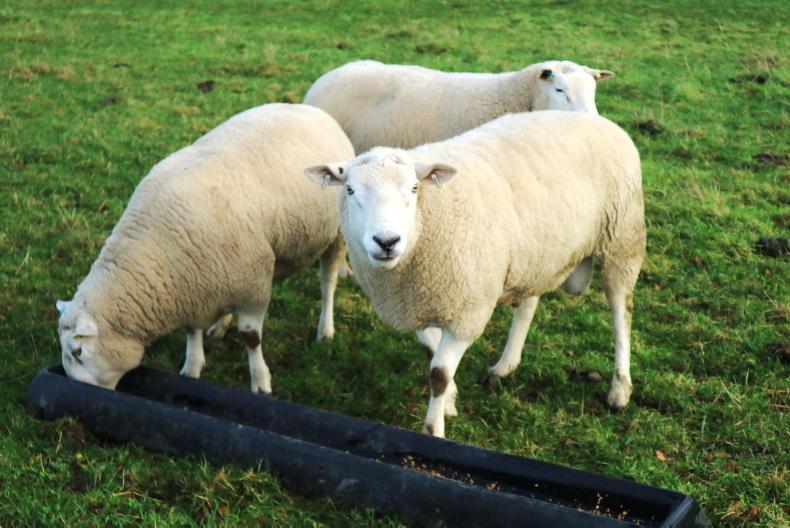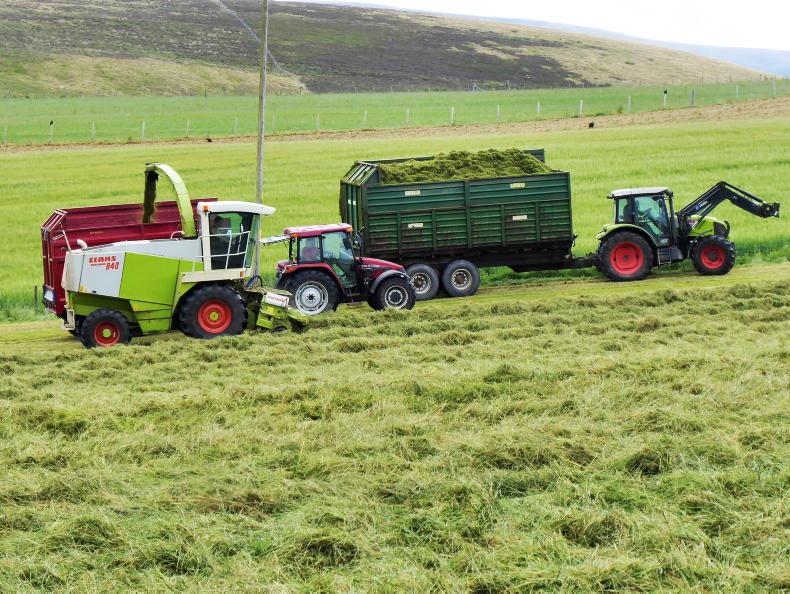The Farm Profit Programme identified a number of attributes that made the project successful on farm. In the first of a two-part series, we discuss the first three things that were put in place on the programme farms to increase gross margin.
During the first year of the project, the requirement of having a plan was demonstrated several times. Project farms benefited greatly from having structure imposed to guide decision making and offer a direction over time.
As the project has progressed, the plan also allowed introspection to ensure goals were met.

The Biffens have introduced composite breeds to their flock.
Biffens’ plan for success
At the start of the programme, Matthew Biffen had not long returned to the farm from University and Andrew’s wife Fiona was keen to get involved in the business.
This meant integrating new people to the business and having them all contribute to and understand the direction that the business would develop in.
The family and programme advisers identified the key areas of the business that offered greatest potential for change and set out a plan.
One of the first challenges was to better integrate the arable and grassland elements of the farm.
Some fields had been in cereals for more than 40 years, so bringing in winter fodder crops was a quick way to break the cycle and reduce the cost to keep the cows over winter.
The plan also set out a rotation, with arable fields going into grass to break the white crop cycle that were then returned to cereals after a two- to four-year break as a grass ley.
Fiona was also keen to develop the ewe flock, so a breeding plan was developed. Over the past five years, the flock has moved from Scotch half-breds to a modern composite breeding its own replacements.
2. Soil health and
fertility
While it is the building block of all farming systems, soil is often the most neglected element.
Across the farms, soils were not just tested for the usual range of nutrients and acidity. Farmers were also encouraged to dig holes and see what was happening.
This led to significant amounts of compaction being found and alleviated.
Some farms demonstrated an oversupply of nutrients due to over-application previously, while others demonstrated severe deficiencies due to the actions of previous occupants.
In working through these problems, the farms now grow more grass.
Duffus family
The programme came along just after Andy and Debbie Duffus had added a nearby farm on the Crown Estate to their current tenancy.
From historic silage yields, it was clear that the leys were underperforming, so comprehensive soil sampling was undertaken.
Initially, programme advisers Robert and Declan recommended 300t of lime to be spread across 90 acres of pasture land.
However, the farm’s budget only stretched to 200t at a cost of £6,400. This raised the pH to an average of 5.6.
Since then, lime applications have resulted in the average pH rising to 5.8, with plans to aim for pH 6.
Low phosphate indices have been addressed with 5t/ha of sewage pellets and low-potash indices have been tackled with distillery waste.
As a result, silage yields have nearly doubled from seven bales to the acre to 12.
3. Maximising the use of grazed grass
Grazed grass is the cheapest feed available to livestock farmers, so it goes without saying that maximising its use in the diet maximises profitability.
Rotational grazing to one extent or another has been initiated across the farms and this has led to significant increases in grass growth.

Rotational grazing has increased output for Andrew Gammie.
Drumforber drives grass
Andrew Gammie runs a pedigree livestock farm on 323 acres of quality lowground land.
To maintain arable output while growing the livestock enterprise, the programme identified the need to implement rotational grazing.
This has allowed Andrew to produce more grass for a cost of less than 6p/kg DM.
After lime was applied to the fields, they were split into five 5ac paddocks, with half the ground in new grass and half in its second year. The rotational grazing really helped the leys to tiller out and thicken beneath the cattle’s feet.
Up to 40 cows were summered on the 25ac block, plus excess grass was taken as silage when growth exceeded demand.
In the first year of the programme, they made 15 acres of extra silage.
This has been a contributing factor in the doubling of the herd to 90 cows while only increasing grassland by 17 acres.
The Farm Profit Programme identified a number of attributes that made the project successful on farm. In the first of a two-part series, we discuss the first three things that were put in place on the programme farms to increase gross margin.
During the first year of the project, the requirement of having a plan was demonstrated several times. Project farms benefited greatly from having structure imposed to guide decision making and offer a direction over time.
As the project has progressed, the plan also allowed introspection to ensure goals were met.

The Biffens have introduced composite breeds to their flock.
Biffens’ plan for success
At the start of the programme, Matthew Biffen had not long returned to the farm from University and Andrew’s wife Fiona was keen to get involved in the business.
This meant integrating new people to the business and having them all contribute to and understand the direction that the business would develop in.
The family and programme advisers identified the key areas of the business that offered greatest potential for change and set out a plan.
One of the first challenges was to better integrate the arable and grassland elements of the farm.
Some fields had been in cereals for more than 40 years, so bringing in winter fodder crops was a quick way to break the cycle and reduce the cost to keep the cows over winter.
The plan also set out a rotation, with arable fields going into grass to break the white crop cycle that were then returned to cereals after a two- to four-year break as a grass ley.
Fiona was also keen to develop the ewe flock, so a breeding plan was developed. Over the past five years, the flock has moved from Scotch half-breds to a modern composite breeding its own replacements.
2. Soil health and
fertility
While it is the building block of all farming systems, soil is often the most neglected element.
Across the farms, soils were not just tested for the usual range of nutrients and acidity. Farmers were also encouraged to dig holes and see what was happening.
This led to significant amounts of compaction being found and alleviated.
Some farms demonstrated an oversupply of nutrients due to over-application previously, while others demonstrated severe deficiencies due to the actions of previous occupants.
In working through these problems, the farms now grow more grass.
Duffus family
The programme came along just after Andy and Debbie Duffus had added a nearby farm on the Crown Estate to their current tenancy.
From historic silage yields, it was clear that the leys were underperforming, so comprehensive soil sampling was undertaken.
Initially, programme advisers Robert and Declan recommended 300t of lime to be spread across 90 acres of pasture land.
However, the farm’s budget only stretched to 200t at a cost of £6,400. This raised the pH to an average of 5.6.
Since then, lime applications have resulted in the average pH rising to 5.8, with plans to aim for pH 6.
Low phosphate indices have been addressed with 5t/ha of sewage pellets and low-potash indices have been tackled with distillery waste.
As a result, silage yields have nearly doubled from seven bales to the acre to 12.
3. Maximising the use of grazed grass
Grazed grass is the cheapest feed available to livestock farmers, so it goes without saying that maximising its use in the diet maximises profitability.
Rotational grazing to one extent or another has been initiated across the farms and this has led to significant increases in grass growth.

Rotational grazing has increased output for Andrew Gammie.
Drumforber drives grass
Andrew Gammie runs a pedigree livestock farm on 323 acres of quality lowground land.
To maintain arable output while growing the livestock enterprise, the programme identified the need to implement rotational grazing.
This has allowed Andrew to produce more grass for a cost of less than 6p/kg DM.
After lime was applied to the fields, they were split into five 5ac paddocks, with half the ground in new grass and half in its second year. The rotational grazing really helped the leys to tiller out and thicken beneath the cattle’s feet.
Up to 40 cows were summered on the 25ac block, plus excess grass was taken as silage when growth exceeded demand.
In the first year of the programme, they made 15 acres of extra silage.
This has been a contributing factor in the doubling of the herd to 90 cows while only increasing grassland by 17 acres.








 This is a subscriber-only article
This is a subscriber-only article











SHARING OPTIONS: